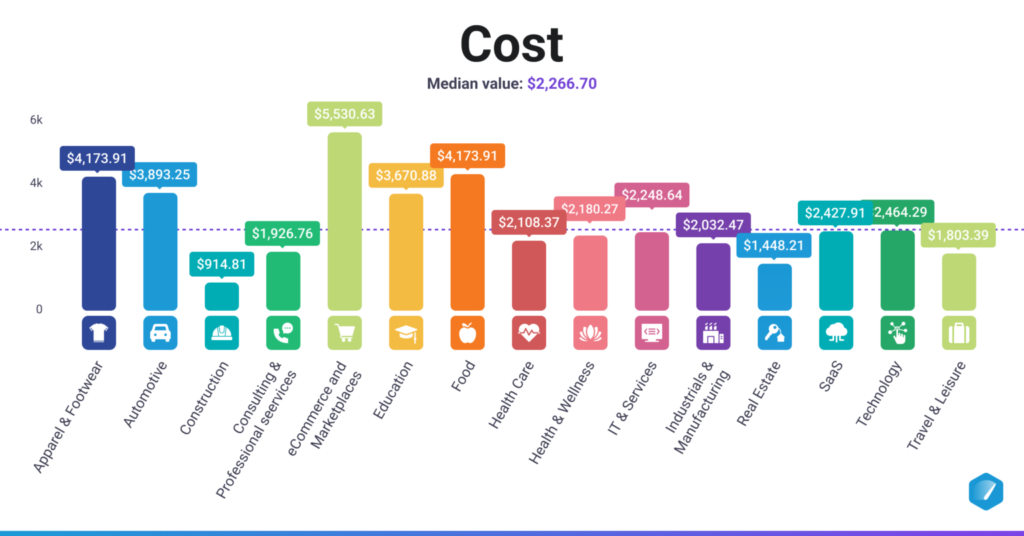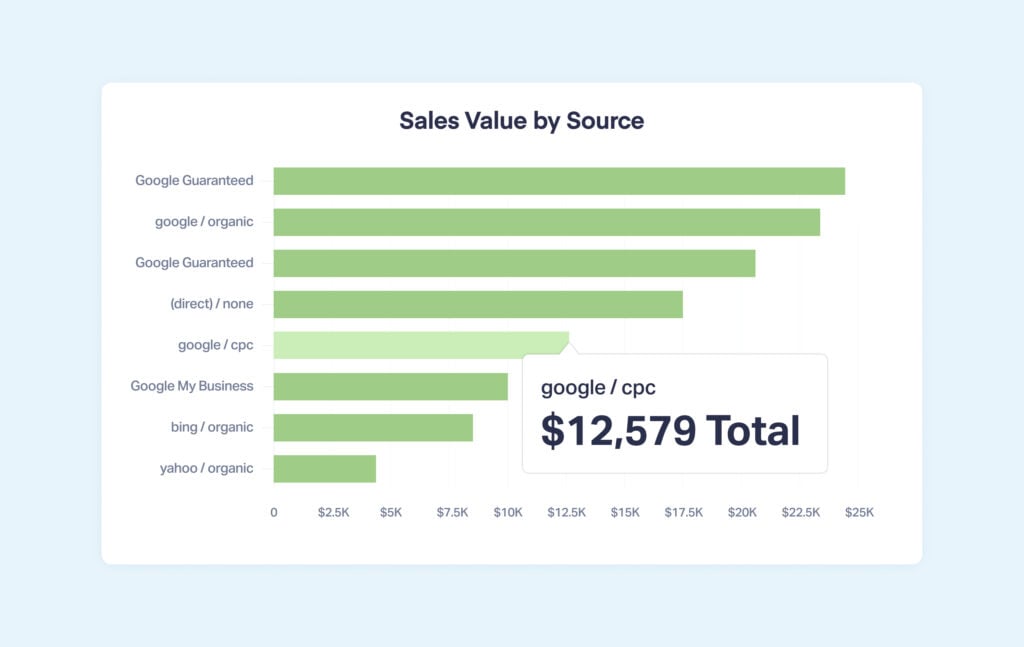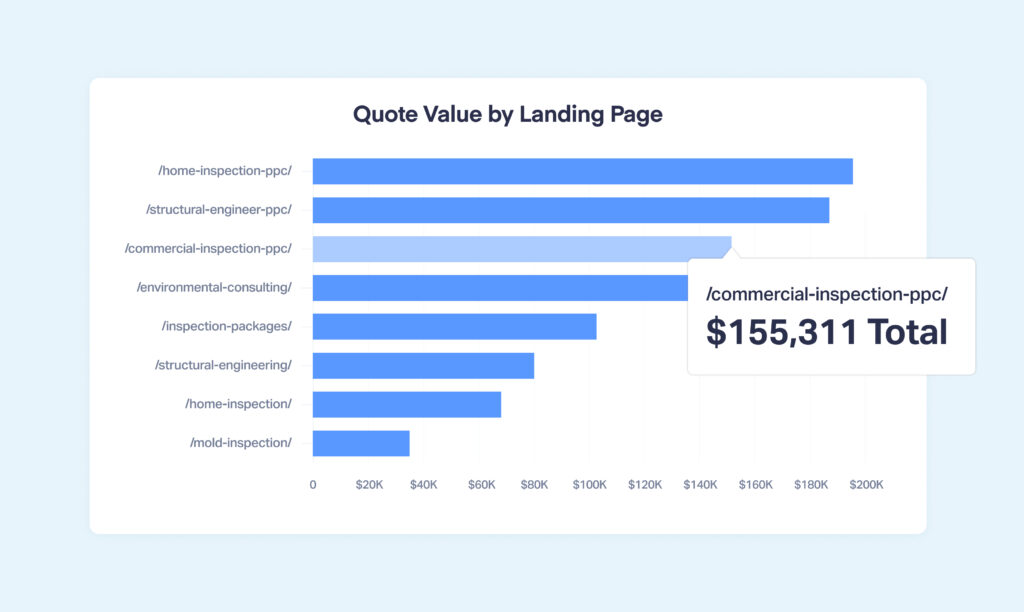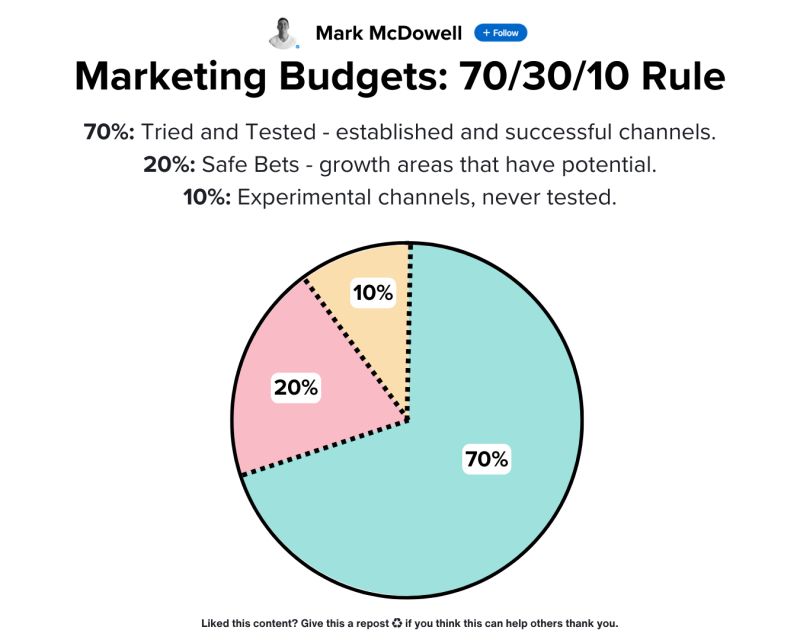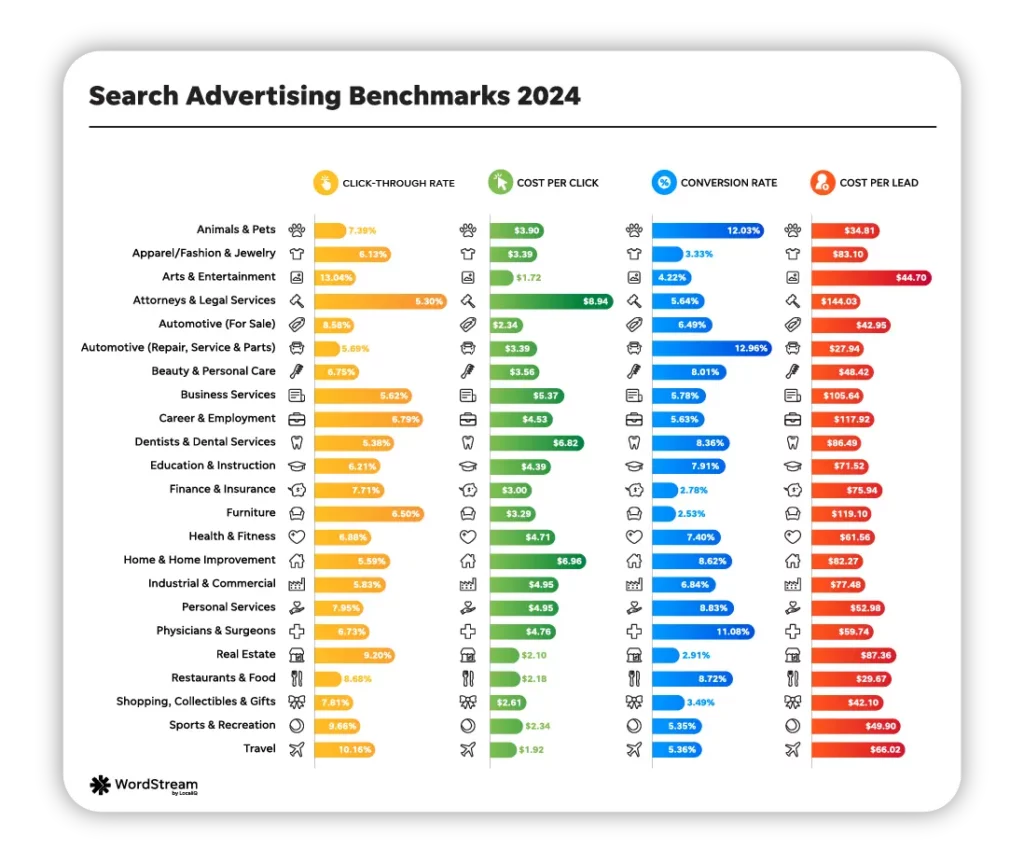
Whether you’re an in-house marketing pro or you’re an agency looking to knock a client’s socks off and win their business, understanding how to create a well-structured PPC marketing budget proposal is a must for getting stakeholder buy-in.
But what should a proposal look like? What information can you include to ensure it gets passed? And how do you make it clear that you’re the confident and competent PPC professional you know yourself to be?
This guide will walk you through the key components of a PPC budget proposal, including understanding budget allocation, defining objectives, analyzing past performance, breaking down costs, forecasting ROI, structuring a compelling marketing budget proposal, and effectively presenting it to stakeholders.
Step 1: Understanding PPC Budget Allocation
How Much Budget Should PPC Get?
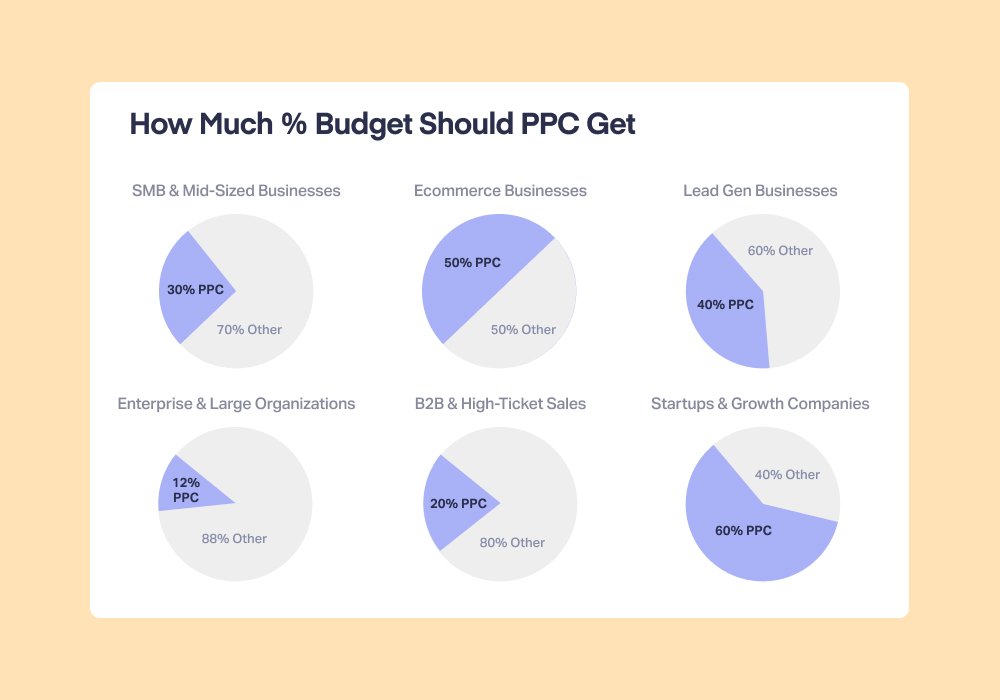
Before you begin creating your PPC marketing budget proposal, it’s worth understanding what a proper budget allocation is for this type of marketing channel. Ultimately, the right budget allocation for your business (or your client’s) will depend on factors like industry, business goals, industry, and risk tolerance. However, below are some helpful general guidelines based on business type.
SMBs & Mid-Sized Businesses:
- Typically allocate 20-40% of their total marketing budget to PPC.
- If PPC is a primary acquisition channel, it can go as high as 50-60%.
E-Commerce & Lead Gen Businesses:
- E-commerce businesses often allocate 40-60% to PPC due to direct ROI tracking.
- Lead generation companies may spend 30-50%, depending on PPC performance.
Enterprise & Large Organizations
- Digital advertising (including PPC) can account for 20–50% of the total marketing budget.
- PPC specifically may range from 20–40% of the total digital spend—more if you rely heavily on direct-response ads.
B2B & High-Ticket Sales:
- B2B businesses often allocate 10-30% to PPC since SEO, content marketing, and email outreach play a bigger role in longer sales cycles.
Startups & Growth Companies:
- Startups often invest heavily in PPC early on (50%+) to gain traction before scaling organic channels.
PPC Budget by Industry
Pay-per-click advertising isn’t as effective in some industries as it is in others. As a result, you’ll want to benchmark your budget allocation against similar businesses. That way, you can get a better sense of what constitutes an aggressive, moderate, and conservative PPC budget.
Here’s a breakdown of average monthly Google Ads spend based on the industry to help you work out your ideal PPC budget:
| Industry | Cost |
| Apparel & Footwear | $4,173.91 |
| Automotive | $3,893.25 |
| Construction | $914.81 |
| Consulting & Professional Services | $1,926.76 |
| eCommerce & Marketplaces | $5,530.63 |
| Education | $3,670.88 |
| Food | $4,173.91 |
| Health Care | $2,108.37 |
| Health & Wellness | $2,180.27 |
| Information Technology & Services | $2,248.64 |
| Industrials & Manufacturing | $2,032.47 |
| Real Estate | $1,448.21 |
| SaaS | $2,427.91 |
| Technology | $2,464.29 |
| Travel & Leisure | $1,803.39 |
Note: Remember, these are average costs. As such, low spenders tend to drag down these numbers while high spenders inflate them. In the end, you’ll want to create your budget around the goals and capabilities that make sense for your business, not just according to benchmarks.
Step 2: Define Your PPC Goals & Objectives
A successful PPC strategy begins with well-defined objectives. Clear goals ensure that your PPC budget aligns with broader business objectives. Common PPC objectives include:
- Brand Awareness – Increasing impressions and ad visibility.
- Lead Generation – Driving high-quality inquiries that are then nurtured into customers.
- Sales & Revenue Growth – Converting website visitors into customers.
- Customer Retention & Remarketing – Engaging existing customers with tailored messaging.
Then, work backward to define specific goals and KPIs that will lead to achieving your business objective.
Setting SMART Goals
To ensure measurable outcomes, use the Specific, Measurable, Achievable, Relevant, and Time-bound (SMART) framework. For example:
"Increase qualified leads by 25% in Q2 while maintaining a CPA under $50."
Align goals with key performance indicators (KPIs), such as click-through rates (CTR), conversion rates, return on ad spend (ROAS), and cost per acquisition (CPA) to track performance effectively. Additionally, setting benchmark KPIs based on industry trends provides context for stakeholders (more on that below).
Aligning Goals with Your Tracking
Be sure your ad KPIs line up with your tracking capabilities. For example, if you’re only able to use an ad platform’s native reporting functions, you might be stuck with vanity metrics (clicks, impressions, etc.).
If you have lead tracking tools like WhatConverts though, you can upgrade your KPIs to quotable leads, sales value, or ROAS by channel.
Step 3: Research & Analyze Your Past PPC Performance
Now that you understand your objectives and goals, it’s time to figure out how to achieve them. And to start, you should look at past performance from your campaigns as well as those from your competition.
Here’s where to start.
Review Past Performance
Start by analyzing any available historical campaign data to identify recurring trends and potential opportunities. Reviewing past performance helps uncover:
- Successful Campaign Strategies: First, identify which campaigns were high-performers in the past. You can do that in WhatConverts with the Campaign by Sales Value report. This shows the most successful campaigns by how much revenue they’ve earned. Once you’ve found the best, work backward and analyze what made these campaigns such a success.
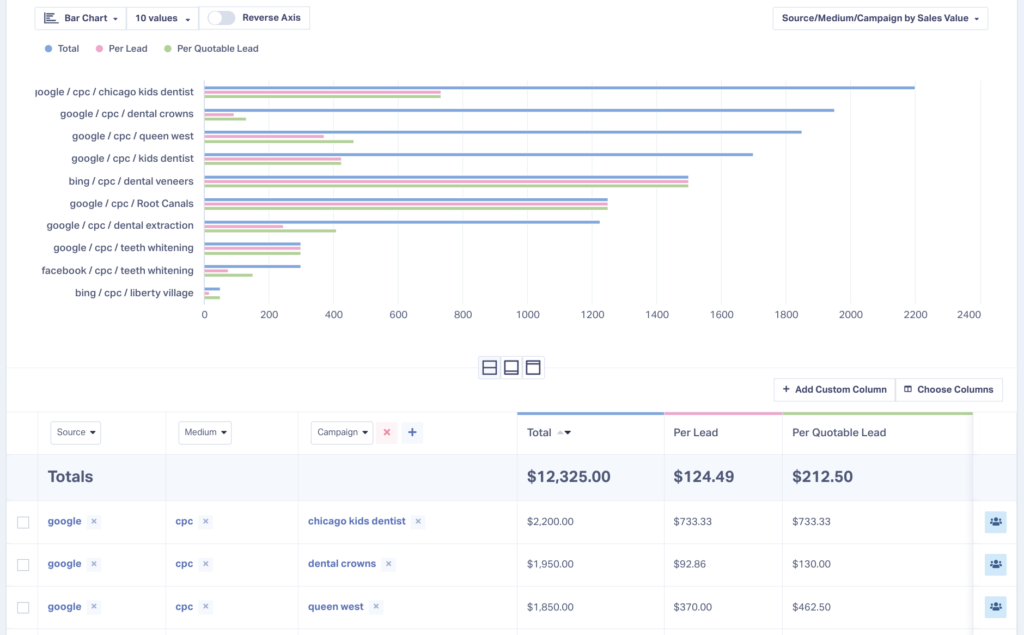
- Trends and Seasonality: Look for periods of high engagement or conversion to understand seasonal impacts. In WhatConverts, you can show conversions by Month, Day of the Week, and even Hour. You can even show it on a keyword level:
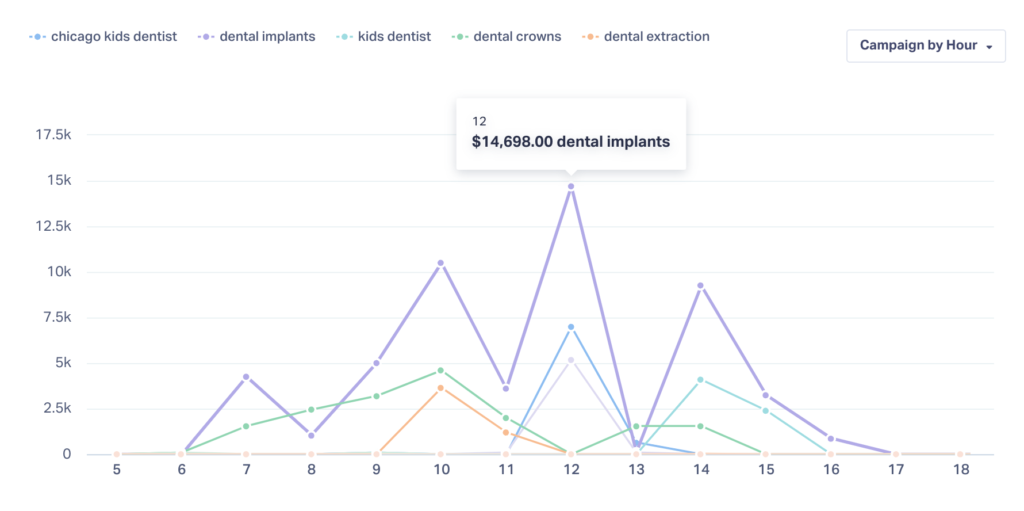
Find New Opportunities
Two ways to find new opportunities are through your own data and through competitor data.
When dealing with your own data, lead tracking tools like WhatConverts can show you which keywords, creatives, and more drove the most value in the past. For example, if you wanted to see sales value by keyword, you could easily generate that report. Then, you could choose to allocate the most budget to the high-performers and reduce the budget to the low-performers. 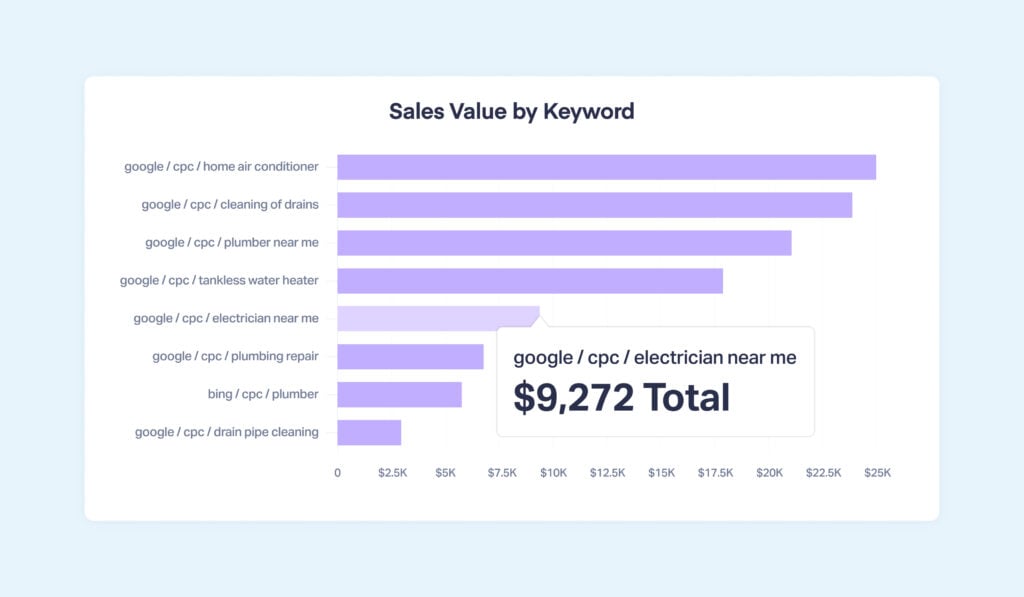
Resource: How to Find Your Best High Value, High Intent Keywords
If you want to mine for opportunities using competitor data, consider using tools like Google Ads Auction Insights, SEMrush, and SpyFu. These tools let you see helpful competitor metrics like average CPC, impression share, and ad positioning. Using this data, you can see gaps in your own strategy that other similar businesses are already capitalizing on.
Calculate Past ROI & CPA
Next, distill all your findings down into dollars. What was the ROI and CPA of your past campaigns?
- ROI (Return on Investment): Use historical data to assess whether past campaigns met profitability expectations. For guidance on what constitutes a good ROAS (Return on Ad Spend), consider insights from WhatConverts on ROAS.
- CPA (Cost Per Acquisition): Determine the average cost to acquire a lead or sale. These metrics provide a baseline for future marketing budget proposals and highlight areas for cost optimization.
Review Your Available Assets
Last but not least, take stock of the advertising assets that will be integral to the success of the campaigns. For instance, are you using existing landing pages and creative components (logos, company images, etc.)? If so, you need to evaluate the quality of these assets to determine how they’ll affect the success of your campaigns.
For example, if you’re an agency tasked with driving leads to a client’s website and getting them to convert, the quality of that site is going to have a massive impact on your conversion rate.
Pro Tip: Work your way backward from the conversion KPI to determine what assets need review.
| KPI Focus | Supporting Assets To Review |
| Ad Clicks | None |
| Leads Generated | Landing page quality, form structure, etc. |
| Sales Value | Customer interaction process (e.g., how are calls being answered, etc.), AOV, CLV |
Step 4: Break Down Your PPC Budget Components
A detailed PPC marketing budget proposal requires breaking down each cost component, ensuring clarity and facilitating strategic allocation.
Ad Spend
Estimate overall expenditure across platforms like Google Ads, Facebook Ads, and LinkedIn Ads. Factor in historical CPCs, CPMs, and conversion rates to allocate budgets where your target audience is most engaged.
Creative Costs
Invest in compelling ad creatives by budgeting for:
- Copywriting: Professional ad copy that drives action.
- Graphic Design: High-quality visuals that capture attention.
- Video Production: Engaging videos to enhance ad performance, if applicable.
Software & Tools
Include expenses for essential PPC management tools such as Google Ads Editor, WhatConverts, and analytics platforms. These tools help streamline campaign management, automate routine tasks, and provide critical performance insights.
Testing & Optimization
Continuous improvement is key:
- A/B Testing: Experiment with different ad copies, visuals, and landing pages to identify the best-performing variations.
- Ongoing Optimization: Regularly adjust bids, keywords, and creative elements based on performance data.
- Data Analysis: Invest in tools or personnel to convert performance metrics into actionable insights.
Breaking down your PPC budget into these components provides transparency and guides strategic resource allocation, ensuring every dollar contributes toward maximizing your return on investment.
Pro Tip: Build growth potential into your budget using the 70/30/10 Rule. This allows for light investment in experimental areas which may open up the door to new channels.
Step 5: Forecast Expected Results & ROI
A well-structured forecast is key to securing stakeholder confidence and proving the value of your PPC investment. To start, estimate essential metrics—clicks, conversions, and cost-per-click (CPC)—using industry benchmarks from reliable sources like WordStream. Combine that with more revenue-specific metrics like quotable leads and sales value.
These data points establish a realistic foundation for your projections.
Projecting Revenue with Historical Data
Use past conversion rate data to predict potential revenue. For example, if your campaigns consistently convert 3% of clicks and your average sale value is $100, you can estimate revenue with this simple formula:
Projected Revenue = (Estimated Clicks) × (Conversion Rate) × (Average Order Value)
This exercise highlights not just potential earnings but also how optimizing conversion rates or lowering CPC could significantly impact profitability.
Simple ROI Calculation for Clear Insights
An easy-to-understand ROI formula helps communicate value to stakeholders:
ROI = (Total Revenue - Total PPC Spend) / Total PPC Spend
This calculation quickly illustrates financial impact and can be adjusted to reflect different conversion rates, CPC fluctuations, or shifts in campaign performance.
Building Budget Scenarios for Smarter Decision-Making
To offer a comprehensive view, develop three budget scenarios:
- Conservative: Assumes higher CPC and lower conversion rates to reflect market downturns or increased competition.
- Moderate: Uses industry benchmarks and historical performance as a baseline.
- Aggressive: Assumes improved campaign performance driven by A/B testing, audience refinement, and bid optimizations.
Presenting these scenarios ensures that decision-makers are prepared for various market conditions and understand the potential risks and rewards of different budget allocations.
By incorporating industry benchmarks, historical data, and strategic scenario planning, your forecast will not only set realistic expectations but also reinforce the rationale behind your PPC budget proposal. A data-driven approach like this makes it easier to secure buy-in and optimize spending for maximum returns.
Step 6: Structure Your PPC Marketing Budget Proposal for Approval
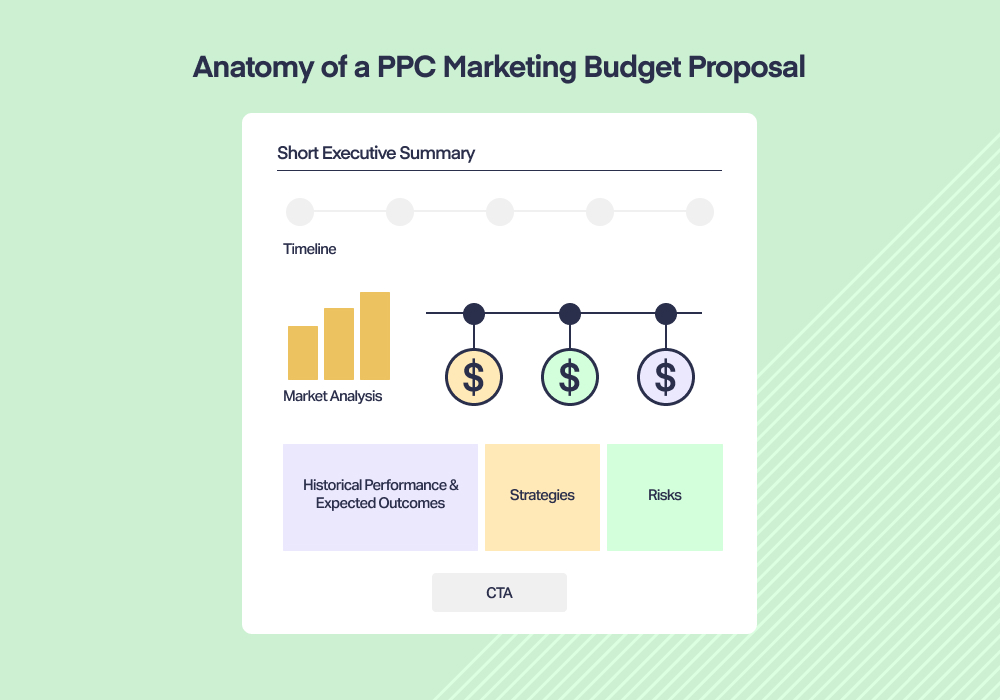
Next, it's time to put all your hard work together into a proper proposal. Below are the nine sections you should include in your PPC marketing budget proposal.
| Section | What It Is | What to Include | Why It Matters |
| Executive Summary | A brief, high-level overview of the proposed PPC budget and goals. | • Key Budget Recommendation (total PPC spend and rationale) • Core Objectives (e.g., leads, revenue, ROAS) • Snapshot of Expected Results (forecasted ROI or conversions) | • Provides decision-makers a quick grasp of the proposal • Sets the stage for more detailed information |
| Objectives & Timeline | A clear statement of your campaign goals and project schedule. | • Specific, measurable objectives (e.g., “Generate 200 qualified leads per month”) • Target Dates for campaign launches, optimizations, and expected results | • Establishes concrete targets and realistic timeframes • Helps stakeholders know when to expect deliverables |
| Budget Breakdown | An itemized list of all PPC-related costs with detailed explanations for each line item. | • Platform Allocations (e.g., Google Ads, Facebook, LinkedIn) • Management Fees • Creative & Production Costs (design, copywriting, landing page creation) • Contingency for unexpected expenses | • Offers transparency on fund usage • Prevents misunderstandings regarding spend allocation |
| Target Audience & Market Analysis | A short overview of who you’re targeting and market conditions affecting PPC performance. | • Demographics & Psychographics (age, interests, job titles, purchasing behavior) • Competitive Landscape (key competitors, average industry CPC, bidding challenges) • Geographical Focus | • Justifies budget by illustrating market size and competitiveness • Informs bidding strategies and creative planning |
| Historical Performance | A recap of past PPC campaigns and the lessons learned from them. | • Key Metrics (previous CPC, CTR, conversion rates, ROI) • Successes & Challenges • Adjustments for the new plan based on past data | • Demonstrates track record and areas for improvement • Builds confidence that the new proposal is data-driven |
| Projected Outcomes | A forecast of expected results such as ROAS, conversions, leads, or revenue. | • ROI Forecast (projected revenue or conversions relative to spend) • Assumptions & Benchmarks (CPC estimates, conversion rates, average order values) • Best-case, worst-case, and likely scenarios | • Provides a tangible estimate for stakeholders • Enables data-driven decision-making |
| Strategies & Tactics | An outline of how you’ll achieve the objectives, covering keywords, audience targeting, creative, etc. | • Keyword Research & Grouping • Audience Segmentation (demographic, behavioral, or remarketing lists) • Creative & Messaging Plan (ad copy concepts, landing page strategy, A/B testing) | • Translates goals into actionable steps • Shows a thoughtful approach to maximizing campaign performance |
| Risks & Contingencies | Potential roadblocks and fallback plans if things do not go as intended. | • External Factors (seasonality, competitor activity, platform changes) • Internal Challenges (budget constraints, limited resources, technical issues) • Contingency Plans for adjustments | • Demonstrates preparedness and flexibility • Reduces stakeholder anxiety by showing readiness for uncertainties |
| Call to Action | The final request for approval and clear next steps. | • Approval Request (specific decisions or sign-off needed) • Implementation Steps (timeline for campaign setup once approved) • Contact Information & Follow-Up for additional details | • Clearly outlines what is needed from decision-makers • Provides a direct path to move the proposal forward |
Step 7: Present and Defend Your Marketing Budget Proposal
The final step is securing stakeholder approval. A strong presentation should be clear, data-driven, and visually compelling. Start with a high-level summary, then walk through key insights, budget breakdowns, and projected ROI.
Tips for success:
- Use visuals – Graphs and charts make complex data easy to understand.
- Anticipate objections – Be ready to justify spend with data on ROI and past performance.
- Offer flexibility – Present multiple budget scenarios (conservative, moderate, aggressive) to show adaptability.
- Highlight tracking – Show how you’ll measure success, optimize campaigns, and adjust spending as needed.
Encourage discussion and feedback, reinforcing that your budget is backed by data and built for performance. A well-structured, insight-driven marketing budget proposal increases stakeholder confidence and ensures approval, setting the stage for PPC success.
Wrapping Up
A well-structured PPC budget proposal isn’t just about numbers—it’s about proving ROI and securing buy-in. By defining goals, analyzing past performance, and forecasting outcomes, you set the stage for smarter ad spend and better results. But even the best budget means nothing without data-driven insights to track what’s working.
That’s where WhatConverts comes in. With our lead tracking and attribution tools, you can see exactly which campaigns, keywords, and channels drive real revenue—not just clicks.
Ready to optimize your PPC budget with complete visibility? Start your free 14-day trial of WhatConverts today!
Get a FREE presentation of WhatConverts
One of our marketing experts will give you a full presentation of how WhatConverts can help you grow your business.
Schedule a Demo
Grow your business with WhatConverts






